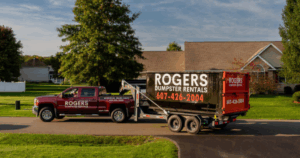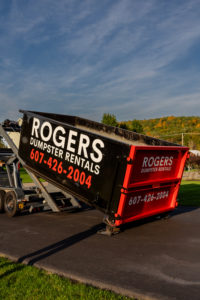Weekend Cleanout? Tips for a 3-Day Dumpster Rental That Saves Money
Tackling a major cleanout over a long weekend is a perfect plan. Whether you’re clearing a garage in Elmira, renovating a basement in Corning, or handling a property cleanout in Sayre, a focused 3-day dumpster rental is your key to a productive and affordable dumpster rental experience. This guide will show you how to plan…
Tackling a major cleanout over a long weekend is a perfect plan. Whether you’re clearing a garage in Elmira, renovating a basement in Corning, or handling a property cleanout in Sayre, a focused 3-day dumpster rental is your key to a productive and affordable dumpster rental experience.
This guide will show you how to plan and execute your weekend project efficiently, ensuring you get the most out of your rental period and budget with Rogers Dumpster Rental, your local partner for waste management services.
Why a 3-Day Weekend Rental is a Smart, Cost-Effective Choice
Opting for a shorter rental period is one of the easiest ways to reduce costs on your residential roll-off dumpster rental. Unlike standard week-long terms, a 3-day rental aligns perfectly with a focused burst of effort, offering significant savings.
- Maximized Value: Schedule your drop-off for Friday morning and pickup for Monday to get three full workdays for the price of a shorter rental, stretching your budget without extra fees.
- Focused Timeline: A clear, three-day deadline helps you stay on task and avoid project drag, ensuring you complete the job efficiently.
- Minimized Obstruction: The dumpster is on your property for a limited time, reducing disruption to your daily life and your neighbors’ space.
Step 1: Strategic Planning Before the Dumpster Arrives
The key to a successful 3-day cleanout is preparation. Do as much work as possible before your 12 yard dumpster or 15 yard dumpster is delivered.
- Sort and Categorize: Create “Keep,” “Donate,” “Recycle,” and “Trash” piles ahead of time. Only the “Trash” pile should go in the dumpster, saving you valuable loading time.
- Disassemble Large Items: Break down old furniture, shelving, and other bulky objects. This saves immense space inside the dumpster and makes items easier to carry.
- Gather Supplies: Have work gloves, sturdy shoes, and a dolly ready. For yard cleanups in areas like Spencer or Van Etten, ensure you have rakes and tarps on hand.
Step 2: Choose the Right Dumpster Size for a Weekend Project
Selecting the correct size is critical for staying on budget. An overloaded dumpster can incur overage fees, while one that’s too large wastes money. For a typical weekend cleanout, a 12 yard dumpster rental or 15 yard dumpster rental is usually ideal.
| Dumpster Size | Ideal For a 3-Day Weekend Project | Considerations |
|---|---|---|
| 12 Yard Dumpster Rental | Single-car garage cleanouts, small basement projects, minor demolition work. | Perfect for homes in Elmira Heights or Pine City where space might be limited. |
| 15 Yard Dumpster Rental | Larger garages, multi-room cleanouts, deck removals, or bathroom remodels. | A versatile size for mid-sized projects in suburbs like Horseheads or Big Flats. |
| 20 Yard Dumpster Rental | Whole-home cleanouts, large-scale landscaping, or major construction debris from a big renovation. | Best for projects generating a very high volume of waste where space isn’t a constraint. |
Unsure? When in doubt, our team can help you choose. We serve homeowners across the region, from Lindley to Waverly and into Pennsylvania communities like Athens and Sayre.
Step 3: Master the Loading Process to Save Space & Money
How you load the dumpster directly impacts how much you can fit and whether you avoid fees. Follow these pro tips to maximize your 12 yard roll-off dumpster :
- Create a Flat Base: Start by placing large, flat items (like doors, plywood, or broken furniture) on the bottom to create a stable foundation.
- Break It Down & Nest: Flatten cardboard boxes and disassemble everything you can. Nest smaller items into the gaps between larger objects, like a game of “dumpster Tetris,” so air doesn’t take up paid space.
- Distribute Weight Evenly: Spread heavy debris (e.g., old books, concrete) evenly across the bottom. Avoid piling it all on one side, which can make transportation difficult.
- Keep it Level: Ensure all debris stays below the fill line. Overfilling is prohibited and can result in additional fees or refusal of pickup.
Step 4: Avoid Surprises by Knowing Prohibited Items
To ensure a smooth pickup and avoid fees, remember that our construction debris dumpster rentals are for non-hazardous materials. Keeping prohibited items out is crucial for affordable dumpster rental.
Prohibited items include:
- Hazardous Waste: Paint, chemicals, solvents, batteries, pesticides.
- Electronics & Appliances: TVs, computers, and appliances that contain refrigerants (such as Freon).
- Other Common Items: Tires, propane tanks, and fluorescent bulbs.
When you book with us, we provide a full list of accepted and prohibited items to keep your project on track and cost-effective.
Your 3-Day Weekend Cleanout Timeline
- Friday (Day 1 – Delivery & Heavy Lifting): The dumpster is delivered in the morning. Focus on loading the heaviest and bulkiest items first to create a stable base.
- Saturday (Day 2 – Main Cleanout): This is your primary workday. Tackle the main volume of the cleanout, using the space-saving loading tips above.
- Sunday (Day 3 – Final Load & Request Pickup): Add the final items, ensuring you haven’t exceeded the fill line. Contact us to schedule pickup for Monday morning.
Ready for a Productive Weekend in the Elmira Area?
Don’t let clutter control your life. A focused weekend with a Rogers Dumpster Rental residential roll-off dumpster rental is the perfect, cost-effective solution. We provide reliable waste management services and commercial dumpster rentals throughout the Southern Tier and Northern Pennsylvania, including Elmira, Corning, Watkins Glen, Montour Falls, Burdett, Beaver Dams, Campbell, Caton, Odessa, Millerton, Ridgebury, Gillett, and beyond.
Contact Rogers Dumpster Rental today to schedule your 3-day weekend rental! We make affordable dumpster rental simple and efficient.


